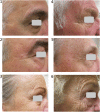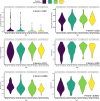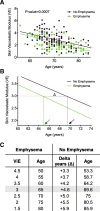Loss of skin elasticity is associated with pulmonary emphysema, biomarkers of inflammation, and matrix metalloproteinase activity in smokers
- PMID: 31234847
- PMCID: PMC6591816
- DOI: 10.1186/s12931-019-1098-7
Loss of skin elasticity is associated with pulmonary emphysema, biomarkers of inflammation, and matrix metalloproteinase activity in smokers
Abstract
Background: Elastin breakdown and the resultant loss of lung elastic recoil is a hallmark of pulmonary emphysema in susceptible individuals as a consequence of tobacco smoke exposure. Systemic alterations to the synthesis and degradation of elastin may be important to our understanding of disease phenotypes in chronic obstructive pulmonary disease. We investigated the association of skin elasticity with pulmonary emphysema, obstructive lung disease, and blood biomarkers of inflammation and tissue protease activity in tobacco-exposed individuals.
Methods: Two hundred and thirty-six Caucasian individuals were recruited into a sub-study of the University of Pittsburgh Specialized Center for Clinically Orientated Research in chronic obstructive pulmonary disease, a prospective cohort study of current and former smokers. The skin viscoelastic modulus (VE), a determinant of skin elasticity, was recorded from the volar forearm and facial wrinkling severity was determined using the Daniell scoring system.
Results: In a multiple regression analysis, reduced VE was significantly associated with cross-sectional measurement of airflow obstruction (FEV1/FVC) and emphysema quantified from computed tomography (CT) images, β = 0.26, p = 0.001 and β = 0.24, p = 0.001 respectively. In emphysema-susceptible individuals, elasticity-determined skin age was increased (median 4.6 years) compared to the chronological age of subjects without emphysema. Plasma biomarkers of inflammation (TNFR1, TNFR2, CRP, PTX3, and SAA) and matrix metalloproteinase activity (MMP1, TIMP1, TIMP2, and TIMP4) were inversely associated with skin elasticity.
Conclusions: We report that an objective non-invasive determinant of skin elasticity is independently associated with measures of lung function, pulmonary emphysema, and biomarkers of inflammation and tissue proteolysis in tobacco-exposed individuals. Loss of skin elasticity is a novel observation that may link the common pathological processes that drive tissue elastolysis in the extracellular matrix of the skin and lung in emphysema-susceptible individuals.
Keywords: COPD; Elasticity; Emphysema; Inflammation; Metalloprotease; Skin.
Conflict of interest statement
The authors declare that they have no competing interests.
Figures



Similar articles
-
Biomarkers of extracellular matrix turnover are associated with emphysema and eosinophilic-bronchitis in COPD.Respir Res. 2017 Jan 19;18(1):22. doi: 10.1186/s12931-017-0509-x. Respir Res. 2017. PMID: 28103932 Free PMC article.
-
Centrilobular emphysema and coronary artery calcification: mediation analysis in the SPIROMICS cohort.Respir Res. 2018 Dec 18;19(1):257. doi: 10.1186/s12931-018-0946-1. Respir Res. 2018. PMID: 30563576 Free PMC article.
-
Value of metalloproteinases in predicting COPD in heavy urban smokers.Respir Res. 2020 Sep 2;21(1):228. doi: 10.1186/s12931-020-01496-9. Respir Res. 2020. PMID: 32878618 Free PMC article.
-
Disease of the airways in chronic obstructive pulmonary disease.Eur Respir J Suppl. 2001 Dec;34:41s-49s. doi: 10.1183/09031936.01.00234601. Eur Respir J Suppl. 2001. PMID: 12392034 Review.
-
Metalloproteases/anti-metalloproteases imbalance in chronic obstructive pulmonary disease: genetic factors and treatment implications.Curr Opin Pulm Med. 2011 Dec;17 Suppl 1:S11-9. doi: 10.1097/01.mcp.0000410743.98087.12. Curr Opin Pulm Med. 2011. PMID: 22209925 Review.
Cited by
-
Perceived Age as a Mortality and Comorbidity Predictor: A Systematic Review.Aesthetic Plast Surg. 2023 Feb;47(1):442-454. doi: 10.1007/s00266-022-02932-5. Epub 2022 Jun 1. Aesthetic Plast Surg. 2023. PMID: 35650301
-
Intradermal Treatment with a Hyaluronic Acid Complex Supplemented with Amino Acids and Antioxidant Vitamins Improves Cutaneous Hydration and Viscoelasticity in Healthy Subjects.Antioxidants (Basel). 2024 Jun 26;13(7):770. doi: 10.3390/antiox13070770. Antioxidants (Basel). 2024. PMID: 39061838 Free PMC article.
-
Elevated plasma level of Pentraxin 3 is associated with emphysema and mortality in smokers.Thorax. 2021 Apr;76(4):335-342. doi: 10.1136/thoraxjnl-2020-215356. Epub 2021 Jan 21. Thorax. 2021. PMID: 33479043 Free PMC article.
-
Reduced decline of lung diffusing capacity in COPD patients with diabetes and metformin treatment.Sci Rep. 2022 Jan 26;12(1):1435. doi: 10.1038/s41598-022-05276-x. Sci Rep. 2022. PMID: 35082306 Free PMC article.
-
Genome-wide identification of copy number variations in wrinkled skin cases of Xiang pigs.Sci Rep. 2024 Aug 24;14(1):19695. doi: 10.1038/s41598-024-70732-9. Sci Rep. 2024. PMID: 39181933 Free PMC article.
References
-
- Eisner MD, Anthonisen N, Coultas D, Kuenzli N, Perez-Padilla R, Postma D, et al. An official American Thoracic Society public policy statement: Novel risk factors and the global burden of chronic obstructive pulmonary disease. Am J Respir Crit Care Med. 2010;182(5):693–718. - PubMed
-
- Watz H, Waschki B, Kirsten A, Müller K-C, Kretschmar G, Meyer T, et al. The metabolic syndrome in patients with chronic bronchitis and COPD: frequency and associated consequences for systemic inflammation and physical inactivity. Chest. 2009;136(4):1039–1046. - PubMed
-
- Frei A, Muggensturm P, Putcha N, Siebeling L, Zoller M, Boyd CM, et al. Five comorbidities reflected the health status in patients with chronic obstructive pulmonary disease: the newly developed COMCOLD index. J Clin Epidemiol. 2014;67(8):904–911. - PubMed
MeSH terms
Substances
Grants and funding
- K24HL123342/National Institutes of Health (US)
- R01HL090648/NH/NIH HHS/United States
- K23HL126912/National Institutes of Health (US)
- UL1TR001857/National Institutes of Health (US)
- P50HL084948/National Institutes of Health (US)
- R01 HL090648/HL/NHLBI NIH HHS/United States
- K23 HL126912/HL/NHLBI NIH HHS/United States
- CURE SAP 4100062224/Pennsylvania Department of Health
- R21 HL129917/HL/NHLBI NIH HHS/United States
- R01HL128289/HL/NHLBI NIH HHS/United States
- P50 HL084948/HL/NHLBI NIH HHS/United States
- R21HL129917/National Institutes of Health (US)
LinkOut - more resources
Full Text Sources
Medical
Molecular Biology Databases
Research Materials
Miscellaneous

